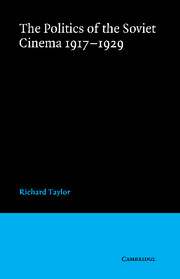Book contents
- Frontmatter
- Contents
- Preface
- Acknowledgements
- Note on transliteration
- Abbreviations
- 1 The pre-history of the Soviet cinema
- 2 The Bolsheviks, propaganda and the cinema
- 3 Revolution and Civil War
- 4 The disorganisation of organisation: the early twenties
- 5 The organisation of disorganisation: the later twenties
- 6 The Party takes control
- 7 Theory and film
- 8 Conclusions
- Notes
- Bibliography
- Index
4 - The disorganisation of organisation: the early twenties
Published online by Cambridge University Press: 07 October 2011
- Frontmatter
- Contents
- Preface
- Acknowledgements
- Note on transliteration
- Abbreviations
- 1 The pre-history of the Soviet cinema
- 2 The Bolsheviks, propaganda and the cinema
- 3 Revolution and Civil War
- 4 The disorganisation of organisation: the early twenties
- 5 The organisation of disorganisation: the later twenties
- 6 The Party takes control
- 7 Theory and film
- 8 Conclusions
- Notes
- Bibliography
- Index
Summary
Things are going badly in the cinema. The cinema is the greatest means of mass agitation. The task is to take it into our own hands.
Stalin, 1924.The conventional structures of the cinema industry in its three major aspects – production, distribution, and exhibition – had been shattered by the Civil War. The shortage of films and equipment meant that priority had to be given to the production of newsreels and agitki and the production of Soviet feature films was consequently neglected. As the existing supply of films was exhausted, as electricity supplies were interrupted, and as the economic crisis worsened, so the number of cinemas still in operation fell. This further reduced income which might have been used to stimulate production. The cinema was caught in a vicious circle. As late as 1923, the journal Kino observed:
We shall not deceive ourselves with faint hopes. The path of regeneration for a shattered industry is difficult. Not only are there no serious resources in the cinema, but the workers and producers are dispersed, disorganised and, to a significant extent, technically backward and unqualified.
Two things above all else were needed for the regeneration of the cinema and for its use as an effective propaganda weapon: organisation and resources. The two principal Soviet film organisations to have survived the Civil War were V.F.K.O. in Moscow and Sevzapkino (Severo–Zapadnoe oblastnoe upravlenie po delam fotografii i kinematografii – North Western Directorate for Photographic and Cinematographic Affairs), formerly P.O.F.K.O. (Petrogradskii oblastnoi fotokinokomitet or Petrograd Regional Photographic and Cinematographic Committee) in Petrograd.
- Type
- Chapter
- Information
- The Politics of the Soviet Cinema 1917–1929 , pp. 64 - 86Publisher: Cambridge University PressPrint publication year: 1979
- 3
- Cited by



